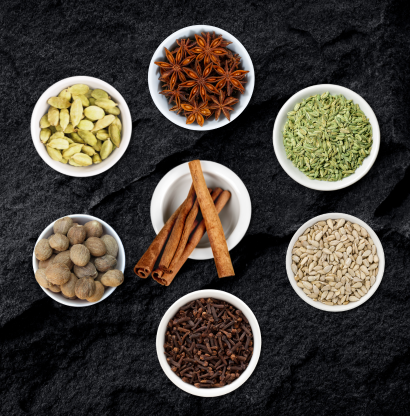If there’s one spice blend that can effortlessly elevate your cooking, it's garam masala. Known for its warm, complex flavour, this versatile spice mix is more than a pantry essential—it’s a gateway to exploring the unique, aromatic world of South Asian and West Indian cuisine. Let’s dive into the origins of garam masala, explore where it’s commonly used, and uncover why this blend deserves a prominent spot in your spice collection.
Origins of Garam Masala
Garam masala originates from the Indian subcontinent, a region renowned for its vibrant and varied culinary traditions. The name “garam masala” itself means “warm spices” in Hindi, with “garam” translating to “warm” or “hot” and “masala” meaning “spice blend.” This “warming” aspect doesn't refer to spiciness but rather to the warming qualities of the spices on the body, according to Ayurvedic principles. The blend is designed to heat the body and improve digestion, especially during cooler seasons. Traditionally, the spices used and their ratios vary widely between regions and even households, which means every blend has its own unique flavour profile.
Key Ingredients in Garam Masala
While recipes vary, traditional garam masala often contains a mixture of spices like cumin, coriander, cardamom, cinnamon, cloves, black pepper, and nutmeg. Some blends may include bay leaves, fennel seeds, or star anise, each adding subtle nuances to the final flavour. These spices are often toasted before grinding, enhancing their natural oils and resulting in a deeper, more fragrant profile.
Using Garam Masala in Meat Dishes
Garam masala works beautifully with a variety of meats, adding complexity without overpowering the natural flavours of the protein. Here are some ways to incorporate it into your meat dishes:
- Curries and Stews: Garam masala is a popular addition to meat-based curries and stews. In chicken tikka masala, for example, the spice blend is often added toward the end of cooking, lending a warm aroma and rich taste to the dish. It pairs well with lamb, beef, and chicken.
- Marinades: Garam masala is a fantastic base for meat marinades. Combine it with yoghurt, garlic, ginger, and a touch of lemon juice to create a marinade that not only tenderizes the meat but infuses it with complex, aromatic flavours.
- Grilled Meat: Try dusting a pinch of garam masala on grilled meats just before serving. The heat from the grill activates the spices, creating an enticing aroma and enhancing the taste of your barbecued dishes.
Using Garam Masala in Vegetarian Dishes
Vegetarian dishes truly benefit from garam masala’s ability to add depth without overpowering the natural ingredients. Here are some ways to make the most of garam masala in vegetarian recipes:
- Lentil and Bean Curries: Garam masala is essential in dishes like chana masala (chickpea curry) and dal (lentil stew). It’s typically added toward the end of cooking to retain its fragrance and add a warm finish to the dish.
- Roasted Vegetables: Toss vegetables such as cauliflower, potatoes, or carrots with garam masala, olive oil, and a pinch of salt before roasting. The spices will infuse the vegetables with a savoury, slightly sweet flavour profile that’s hard to resist.
- Soups and Stews: Add a pinch of garam masala to vegetable soups or stews to give them a warm, comforting flavour. It pairs particularly well with creamy butternut squash or pumpkin soups, enhancing their natural sweetness.
- Rice and Grain Dishes: Garam masala can also add depth to rice and other grains. Stir it into your rice pilafs, quinoa, or couscous for an aromatic touch. A sprinkle of garam masala in biryani or pulao gives the dish an authentic, fragrant quality.
Tips for Using Garam Masala
- Add It Towards the End of Cooking: Garam masala is generally added toward the end of cooking to preserve its delicate aromas. Unlike spices like cumin or coriander, which are often added at the start, garam masala shines when used as a finishing spice.
- Experiment with Small Quantities: Start with a small amount and adjust to taste. Garam masala is potent, and a little goes a long way. It’s better to add it gradually to avoid overpowering the dish.
- Store it Properly: To maintain its freshness, store garam masala in an airtight container in a cool, dark place. Since it’s made from ground spices, it can lose its potency over time, so it’s best used within a few months for maximum flavour.
Why Garam Masala Deserves a Place in Your Pantry
Garam masala’s versatility, warm flavour, and global appeal make it a must-have in any kitchen. Whether you’re cooking meat or vegetarian dishes, this spice blend brings a unique depth and warmth that enhances the natural flavours of your ingredients. With just a small sprinkle, garam masala can transform a simple dish into a delightful culinary experience, perfect for family dinners or special occasions.
In short, garam masala offers a taste of tradition and a hint of adventure. So, next time you’re looking to add something special to your cooking, reach for garam masala and experience the magic of South Asian cuisine from your own kitchen.












